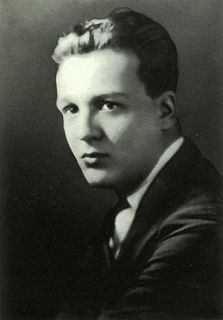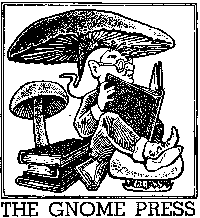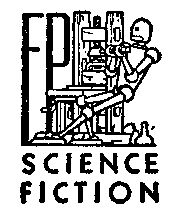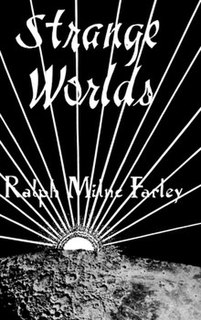Related Research Articles

Stanley Grauman Weinbaum was an American science fiction writer. His first story, "A Martian Odyssey", was published to great acclaim in July 1934; the alien Tweel was arguably the first character to satisfy John W. Campbell's challenge: "Write me a creature who thinks as well as a man, or better than a man, but not like a man." Weinbaum wrote more short stories and a few novels, but died from lung cancer less than a year and a half later.

Works of fiction about the planet Venus have been written since before the 19th century. Its impenetrable cloud cover gave science fiction writers free rein to speculate on conditions at its surface; as it is very similar in size to Earth but closer to the Sun, the planet was often depicted as warmer but still habitable by humans. Depictions of Venus as a lush, verdant paradise, or fetid swampland, often inhabited by dinosaur-like monsters, became common in early pulp science fiction, particularly between the 1930s and 1950s, when science had revealed some aspects of Venus but not yet the harsh nature of its surface conditions. From the mid-20th century on, as the reality of Venus as a hostile, toxic inferno became known, the early tropes of adventures in Venusian tropics gave way to more realistic stories of the planet's colonization and terraforming.

Roger Sherman Hoar was an American state senator and assistant Attorney General, for the state of Massachusetts. He also wrote science fiction under the pseudonym of Ralph Milne Farley.

Gnome Press was an American small-press publishing company primarily known for publishing many science fiction classics. Gnome was one of the most eminent of the fan publishers of SF, producing 86 titles in its lifespan — many considered classic works of SF and Fantasy today. Gnome was important in the transitional period between Genre SF as a magazine phenomenon and its arrival in mass-market book publishing, but proved too underfunded to make the leap from fan-based publishing to the professional level. The company existed for just over a decade, ultimately failing due to inability to compete with major publishers who also started to publish science fiction. In its heyday, Gnome published many of the major SF authors, and in some cases, as with Robert E. Howard's Conan series and Isaac Asimov's Foundation series, was responsible for the manner in which their stories were collected into book form.
Galaxy novels, sometimes titled Galaxy Science Fiction Novels, were a series of mostly reprint American science fiction novels published between 1950 and 1961.

Fantasy Press was an American publishing house specialising in fantasy and science fiction titles. Established in 1946 by Lloyd Arthur Eshbach in Reading, Pennsylvania, it was most notable for publishing the works of authors such as Robert A. Heinlein and E. E. Smith. One of its more notable offerings was the Lensman series.

The Red Peri is a collection of science fiction short stories by American writer Stanley G. Weinbaum. It was first published in 1952 by Fantasy Press in an edition of 1,732 copies. The stories originally appeared in the magazines Amazing Stories, Astounding and Thrilling Wonder Stories.
Grant-Hadley Enterprises was the first of three names used by an American small press publishing house specializing in science fiction titles. The company was founded in 1945 by Donald M. Grant and Thomas G. Hadley and published one title as Grant-Hadley Enterprises. Kenneth J. Krueger joined the company in 1946 and the name was changed to The Buffalo Book Company. Later in 1946, Hadley continued the company on his own as The Hadley Publishing Co.
Shasta Publishers was a science fiction and fantasy small press specialty publishing house founded in 1947 by Erle Melvin Korshak, T. E. Dikty, and Mark Reinsberg, who were all science fiction fans from the Chicago area. The name of the press was suggested by Reinsberg in remembrance of a summer job that he and Korshak had held at Mount Shasta.

Slaves of Sleep is a science fantasy novel by American writer L. Ron Hubbard. It was first published in book form in 1948 by Shasta Publishers; the novel originally appeared in 1939 in an issue of the magazine Unknown. The novel presents a story in which a man travels to a parallel universe ruled by Ifrits. The protagonist takes on the identity of a human in this dimension, and becomes involved in the politics of Ifrits in this fictional "Arabian Nights" world.
William Levi Crawford was an American publisher and editor.

The Sunken World is a science fiction novel by American writer Stanton A. Coblentz. It was first published in book form in 1948 by Fantasy Publishing Company, Inc. in an edition of 1,000 copies. The novel originally appeared in the Summer 1928 issue of the magazine Amazing Stories Quarterly. It was Coblentz's first published science fiction novel.

The Radio Man is a science fiction novel by American writer Ralph Milne Farley. It is the first book in Farley's Radio Man series. The novel was originally serialized from the June 28, 1924 issue of Argosy. It was first published in book form in 1948 by Fantasy Publishing Company, Inc. in an edition of 1,000 copies. Modern publishers often release The Radio Man under the title An Earth Man on Venus.

After 12,000 Years is a science fiction novel by American writer Stanton A. Coblentz. It was first published in book form in 1950 by Fantasy Publishing Company, Inc. (FPCI) in an edition of 1,000 copies, of which 750 were hardback. Lloyd Arthur Eshbach regarded this as one of the stronger titles published by FPCI. Considered one of the author's most bizarre and most interesting futuristic fantasies, the novel originally appeared in the Spring 1929 issue of the magazine Amazing Stories Quarterly. The novel was abridged for the FPCI publication. E. F. Bleiler considered the unabridged version to be superior.

Science-Fantasy Quintette is a collection of science fiction short stories by Aerican writers L. Ron Hubbard and Ed Earl Repp, edited by William L. Crawford. It was published in 1953 by Fantasy Publishing Company, Inc. in an edition of 300 copies. The book is an omnibus of Repp's The Radium Pool and Hubbard's Triton. The stories originally appeared in the magazines Unknown, Amazing Stories, Fantasy Book and Science Wonder Stories.

Strange Worlds is a collection of science fiction by Ralph Milne Farley. Consisting of one novel and two shorter novellas, it was first published in 1953 by Fantasy Publishing Company, Inc. in an edition of 300 copies. The book is an omnibus of Farley's earlier books, The Radio Man and The Hidden Universe. The novel was originally serialized in the magazine Argosy and the novellas originally appeared in the magazine Amazing Stories.

Science and Sorcery is an anthology of fantasy and science fiction stories edited by Garret Ford. It was published by Fantasy Publishing Company, Inc. in 1953 in an edition of 500 copies. Most of the stories originally appeared in the magazine Fantasy Book. Others appeared in the magazines Thrilling Wonder Stories, The Vortex and Weird Tales.

Two Complete Science-Adventure Books was an American pulp science fiction magazine, published by Fiction House, which lasted for eleven issues between 1950 and 1954 as a companion to Planet Stories. Each issue carried two novels or long novellas. It was initially intended to carry only reprints, but soon began to publish original stories. Contributors included Isaac Asimov, Robert A. Heinlein, Arthur C. Clarke, Poul Anderson, John Brunner, and James Blish. The magazine folded in 1954, almost at the end of the pulp era.

Amazing Stories Quarterly was a U.S. science fiction pulp magazine that was published between 1928 and 1934. It was launched by Hugo Gernsback as a companion to his Amazing Stories, the first science fiction magazine, which had begun publishing in April 1926. Amazing Stories had been successful enough for Gernsback to try a single issue of an Amazing Stories Annual in 1927, which had sold well, and he decided to follow it up with a quarterly magazine. The first issue of Amazing Stories Quarterly was dated Winter 1928 and carried a reprint of the 1899 version of H.G. Wells' When the Sleeper Wakes. Gernsback's policy of running a novel in each issue was popular with his readership, though the choice of Wells' novel was less so. Over the next five issues, only one more reprint appeared: Gernsback's own novel Ralph 124C 41+, in the Winter 1929 issue. Gernsback went bankrupt in early 1929, and lost control of both Amazing Stories and Amazing Stories Quarterly; associate editor T. O'Conor Sloane then took over as editor. The magazine began to run into financial difficulties in 1932, and the schedule became irregular; the last issue was dated Fall 1934.

Fantasy Book was a semi-professional American science fiction magazine that published eight issues between 1947 and 1951. The editor was William Crawford, and the publisher was Crawford's Fantasy Publishing Company, Inc. Crawford had problems distributing the magazine, and his budget limited the quality of the paper he could afford and the artwork he was able to buy, but he attracted submissions from some well-known writers, including Isaac Asimov, Frederik Pohl, A. E. van Vogt, Robert Bloch, and L. Ron Hubbard. The best-known story to appear in the magazine was Cordwainer Smith's first sale, "Scanners Live in Vain", which was later included in the first Science Fiction Hall of Fame anthology, and is now regarded as one of Smith's finest works. Jack Gaughan, later an award-winning science fiction artist, made his first professional sale to Fantasy Book, for the cover illustrating Smith's story.
References
- Chalker, Jack L.; Mark Owings (1998). The Science-Fantasy Publishers: A Bibliographic History, 1923-1998. Westminster, MD and Baltimore: Mirage Press, Ltd. pp. 243–245, 267–274, 704–707, 823.
- Clute, John; Peter Nicholls (1995). The Encyclopedia of Science Fiction . New York: St. Martin's Griffin. pp. 272, 411–412. ISBN 0-312-13486-X.
- Eshbach, Lloyd Arthur (1983). Over My Shoulder: Reflections on a Science Fiction Era. Philadelphia: Oswald Train. pp. 251–264. OCLC 10489084.